On the Chinatown Labor History tour (part of Laborfest) Charlie Chin, the artist in residence at the Chinese Historical Society, gave an incredibly well composed and articulate walking tour. He didn’t cover labor so much as the whole history of Chinese in the U.S. up to the present. One of many tidbits I learned is that these weird bricks sticking out of various buildings (this photo is of the Donaldina Cameron bldg., the old baptist church on Sacramento Street) around town were originally melted in the 1700 degree Fahrenheit firestorm of 1906 and were scavenged and used again in the rebuilding. He had a funny name for the them, but I forget what it was. Here’s a couple more images from the tour, a panel of the mural on Stockton highlighting the role of Chinese labor in building the Transcontinental Railroad, Charlie Chin addressing the tour, and a view of one of the first buildings rebuilt in Chinatown after the 1906 quake and fire, this one by a guy who was half Chinese, half Indian from Mendocino. Local merchants put up a mighty fight to keep their property and stay where Chinatown is today, since the local elite made a big effort to remove the Chinese to Hunter’s Point, then a Chinese shrimping village. An odd twist of history is that with the new T light rail line on 3rd Street, and its eventual connection to underground stations beneath Chinatown, the settling of Chinese immigrants in Bayview/Hunter’s Point is once again accelerating.
Lots of reading lately, all too much of it online… How few hours I’ve spent sitting with a good book in the past few months? less than 10, not counting the reading I do every night… which just climaxed last night with the completion of the 3rd volume of the amazing series by Sergei Lukyanenko, Night Watch, Day Watch, and Twilight Watch.
“Of all the cafes and restaurants that Assol was crammed with, the only one working was the cafe in the supermarket. A very nice cafe, on the second-floor mezzanine, above the checkouts with an excellent view of the entire hall of the supermarket. It had to be a good place to drink a nice of cup of coffee, mapping out your route for a pleasant stroll as you bought the groceries–doing your “shopping”: that terribe word, that monstrous Anglicism that has eaten its way into the Russian language, like a tick boring into its helpless prey.”
That kind of aside–which is not the main concern of these fascinating novels about “Others”, magicians and werewolves, witches and vampires, Dark Ones and Light Ones in a timeless battle of good and evil, presided over by the Inquisition–points to the deeper sensibilities that the metaphorical novels cut to: a fascinating critical engagement with the actual dilemmas facing modern life. It’s all couched in a sometimes hilarious confrontation of police-like bureaucracies, who mostly duke it out in a tightly regulated choreography in spaces invisible to the rest of us “normal” humans, but they all, whether Dark or Light, depend on human energy to feed their extraordinary powers. How they manage their moral choices as individual agents of the Night Watch (Light Others patrolling the bad behavior of Dark Others) or the Day Watch (Dark Others patrolling the bad behavior of Light Others), is the driving theme of the trilogy. I absolutely loved all three books (thanks to Giovanni for recommending them to me!)…
They’re set in Russia, and Russia is still very much at the center of world history here at the dawn of the 21st century. In fact, I still favor Asia Times for my daily news these days, with its numerous intelligent analysts, examining politics in China, India, SE Asia, Russia, the Great Game, the Middle East, and more. They reprint stuff from Tom Englehardt pretty often too, and sometimes stuff from Counterpunch. Here’s a recent post at Asia Times that I thought very helpful:
Debt capitalism Self Destructs Henry CK Liu is a monetarist I think. He offers in this piece a very long analysis of how the world economy got into the pickle it’s in now. If you want to understand how the last few decades ponzi schemes and smoke and mirrors are coming unravelled (in ways that some traditional economists have been insisting it would all along, contrary to the Young Turks of New Financial Instruments), this is a good place to start, though it does take some effort to plow through it all…
Our National Water Policy”¦ Oh, Wait, We Don’t Have One If you’re thinking about the basics these days, and you can’t get much more basic than water, this article is a great summary of the efforts by biologists, hydrologists and other concerned scientists to revamp the U.S. approach to water management, going back to Truman’s presidency in the early 1950s, and all the way to the present. What a disaster! It’s REALLY hard to imagine turning this around and applying the enormous resources of the Federal gov’t. to a coherent approach to watersheds, bioregions, etc. But interestingly, that’s precisely the approach/argument of thousands of people that have been organizing under the radar going back to the 1970s. Nowtopia addresses this somewhat obliquely, but anyway, this permacultural approach to water policies is LOOOOONNNGGG overdue, and will soon emerge as a key political vector from which to launch a more thorough-going transformation of how we think about politics, governance, and daily life.
Resilient Community: Technological Acceleration This is John Robb at Global Guerrillas in one of his succinct summary posts (most are kind of like that), laying out a quick overview of why it’s possible (certainly not guaranteed) that we can emerge from this chaotic period of history far more decentralized, technologically sophisticated in ways that make ecological sense, and with a heightened engagement with a profoundly democratic everyday life. Still quite odd to me that this guy who is very much in a different ideological camp keeps sync-ing up with my Nowtopian arguments so well! Does it mean my own arguments are really reactionary? I’m sure some folks think so… but I tend to think it speaks more to the fact that the old political boundaries and categories we received from the past 2-3 centuries have really become useless now. People have to band together where they are and do what they can, and as Robb’s been pointing out, that’s quite a lot… when I talk to people about staying “radically patient” and doing what they can, I’m trying to help people accept that they can only do what they can do (which is not to say that everyone is doing everything they CAN do!)…
Economic Realities Are Killing Our Era of Fantasy Politics A piece that started in Rolling Stone and I found via Alternet, once again pointing out the obvious, that the working class (known in these kinds of articles as the “middle class”) is getting hammered, living standards are plunging, and the super rich are raking it in at everyone else’s expense. Class war, but wildly one-sided, and in constant denial about itself. More facts and figures in this piece, but nothing you haven’t seen popping up in the MSM pretty steadily over the past few years.
Archdruid: Dreams of a Better World My pal Danny turned me on to this very intelligent rejoinder to the gloom-and-doom radicals who think the collapse of modern civilization is going to somehow leave us in a better place than we are now. This guy is more of a philosopher/spiritualist than I could ever be, and he couches a lot of his discussion in terms of myth, but he starts out with a bang and puts the anti-Enlightenment folks in the dumb religious basket where they belong. I especially appreciated his pointed assertion that anyone who thinks they’ll have a better life when the water stops running and the electricity goes off for good is just deluding themselves. That loops us back to the Resilient Communities argument Robb makes…
Anyway, on top of all this I’m keeping up with Harper’s, The New Yorker, Orion, and a few other pubs, plus putting in scads of hours again to Shaping San Francisco (whipping the wiki version into presentable shape between now and Oct. 1 rollout), pitching a new book idea to City Lights, approaching a few other projects, planning a short-ish visit to Toronto and NYC and Troy NY in September, and and and and…
Some random photos to top off this scattered entry… first, walking on Howard near 6th the other day I caught this clear image of the slowly slumping Victorian next to one of our new Lawyer Loft condos. Which will fall first?
After the 1906 quake there were 20,000 shacks built to house the refugees. Some dozens of them still dot the local hills but are usually hidden behind modern facades, or incorporated into newer buildings. I’ve walked by 21st and Collingwood dozens of times in the past few years but the other day this building jumped out at me as a likely shack-within-a-modern-house:
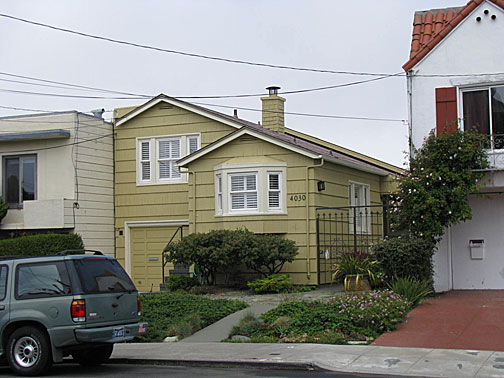
Lastly, the Corwin Community Garden is a real gem, tucked in between a bunch of ugly 1960s buildings on a lot from Corwin on the west to Eagle on the East, in upper Eureka Valley. The garden was planted in 1995, a generation after the neighbors blocked bulldozers and eventually got the land incorporated into an early open space purchase. The garden is full of local native flowers and trees, and a smattering of compatible species from other parts of the west. Here’s a look at the Buckeyes which are growing larger every year, and are flourishing in this patch that has attracted over 100 different butterfly and bird species over the years. Check it out!

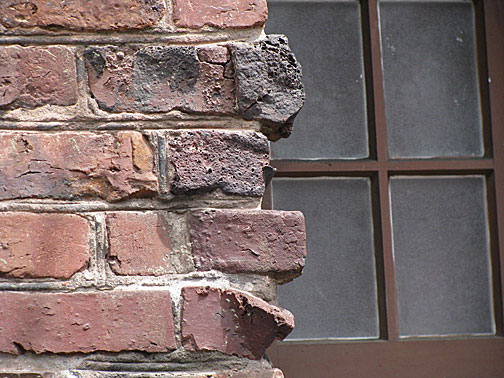
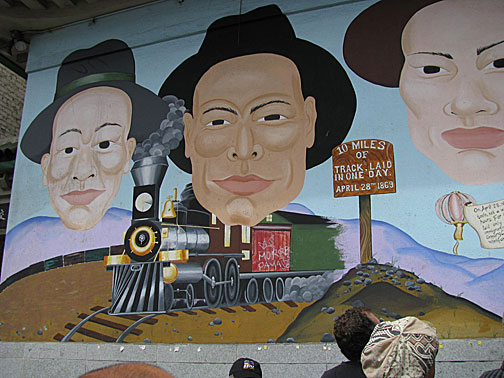
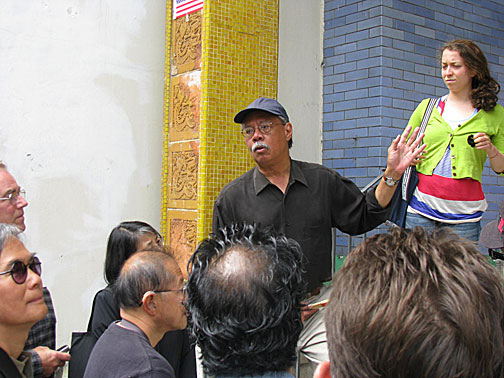
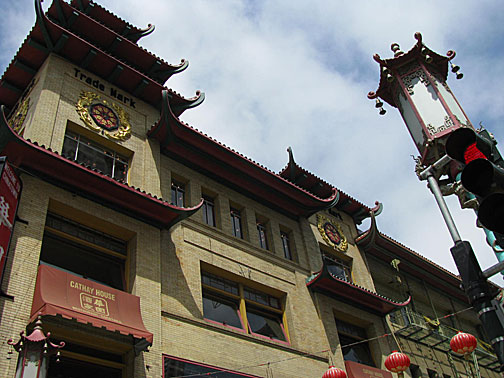
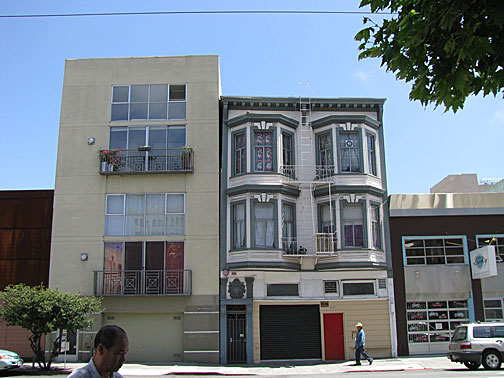
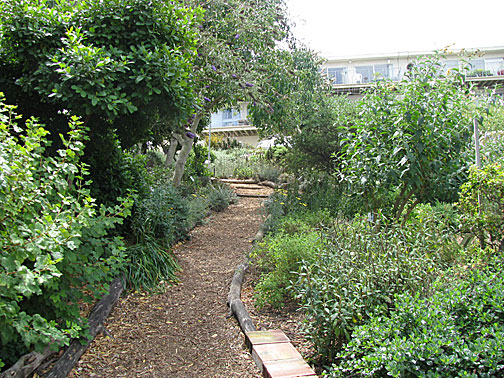











Leave a Reply